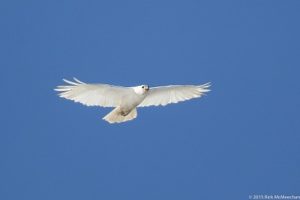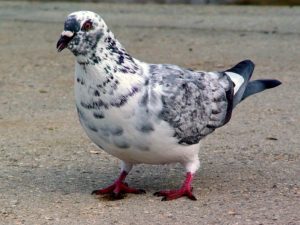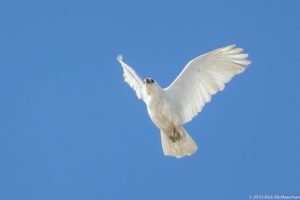Have you ever been hiking in CVNP and looked up to see a big white bird flying overhead? Maybe you thought it was a confused snowy owl or a white dove. Look again: It might’ve been a hawk with leucism, a rare condition that causes partial loss of pigmentation in animals.
There’s at least one leucistic red-tailed hawk in the Cuyahoga Valley, although there are likely other birds with leucism. This week, learn about leucistic hawks and other animals (and how they’re different from albinos) and how you can learn to identify these odd-looking creatures.
Leucism 101
A leucistic red-tailed hawk soars in the blue sky above CVNP. (Photo: Rick McMeechan)
Leucistic animals have a condition that causes partial pigmentation loss. That means that their skin, feathers, and hair are typically white, pale, or peachy-colored.
Commonly, instead of being entirely white, a leucistic animal may have irregular patches of white among its normal coloring. This partial leucism is known as a “piebald” effect.
A leucistic rock pigeon shows off an example of piebald feathers.
Leucism can be caused by injury, poor nutrition, or a genetic imbalance. The pattern of white on piebald animals can vary greatly across generations, and even among siblings from the same parents.
Leucism is uncommon, but as a population grows, it’s more likely a leucistic animal will show up in the community. For example, red-tailed hawks are one of North America’s most common raptors, so it’s not unusual to spot a leucistic red-tailed hawk. Robins are another frequently-seen leucistic bird.
Leucism Vs. Albinism
Note the dark eyes of this leucistic red-tailed hawk, unlike the red eyes of an albino animal. (Photo: Rick McMeechan)
You’ve probably heard of albino animals and have seen photos of their startling white color. So what’s the difference between a leucistic animal and an albino animal?
Albinos can’t produce a specific pigment, called melanin, in their body at all. Leucism, on the other hand, prevents melanin and other pigments from being deposited normally on an animal’s skin, fur, or feathers.
The easiest way to spot the difference between leucism and albinism is in an animal’s eyes. Because of the lack of melanin production in parts of their eye, albinos typically have red eyes. This eerie phenomenon is actually a result of the underlying blood vessels showing through. In contrast, leucistic animals usually have normal-colored eyes.
Another quirk: Leucism typically affects darker colors to a greater degree. That means that if an animal has a mixture of light and dark coloring, like a red-winged blackbird or pileated woodpecker, it might retain an odd mix of white and bright colors.
Spotting Leucistic Animals
It can be tricky to figure out what you’re looking at when you first spot a leucistic animal, particularly a bird. Remember to look for other clues, like body shape, calls, songs, and habitat, to identify these creatures.
You can also keep your eyes open for other hints about the animal’s coloring, too, like the color of its eyes and feet, as well as any spots that still retain some color.
For several years, a leucistic red-tailed hawk has made CVNP its home—check out the photos throughout this post for a glimpse. Look for this unusual hawk flying near the Everett Covered Bridge trailhead or along Riverview Road.
If you think you’ve spotted a leucistic animal in the national park, take a photo and send it to us at info@forcvnp.org!








